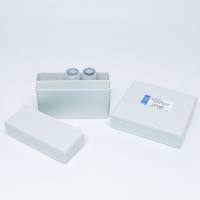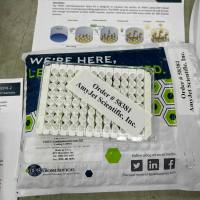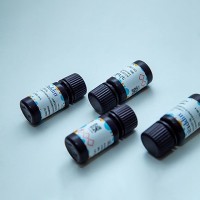Engineering Customized TALE Nucleases (TALENs) and TALE Transcription Factors by Fast Ligation‐Based Automatable Solid‐Phase High‐Throughput (FLASH) A
互联网
- Abstract
- Table of Contents
- Materials
- Figures
- Literature Cited
Abstract
Customized DNA?binding domains made using transcription activator?like effector (TALE) repeats are rapidly growing in importance as widely applicable research tools. TALE nucleases (TALENs), composed of an engineered array of TALE repeats fused to the FokI nuclease domain, have been used successfully for directed genome editing in various organisms and cell types. TALE transcription factors (TALE?TFs), consisting of engineered TALE repeat arrays linked to a transcriptional regulatory domain, have been used to up? or downregulate expression of endogenous genes in human cells and plants. This unit describes a detailed protocol for the recently described fast ligation?based automatable solid?phase high?throughput (FLASH) assembly method. FLASH enables automated high?throughput construction of engineered TALE repeats using an automated liquid handling robot or manually using a multichannel pipet. Using the automated approach, a single researcher can construct up to 96 DNA fragments encoding TALE repeat arrays of various lengths in a single day, and then clone these to construct sequence?verified TALEN or TALE?TF expression plasmids in a week or less. Plasmids required for FLASH are available by request from the Joung lab (http://eGenome.org). This unit also describes improvements to the Zinc Finger and TALE Targeter (ZiFiT Targeter) web server (http://ZiFiT.partners.org) that facilitate the design and construction of FLASH TALE repeat arrays in high throughput. Curr. Protoc. Mol. Biol. 103:12.16.1?12.16.18. © 2013 by John Wiley & Sons, Inc.
Keywords: FLASH; TALEN; TALE; TAL effector; TALE activator
Table of Contents
- Introduction
- Basic Protocol 1: Identification of Target Sites Using ZiFiT Targeter Software
- Basic Protocol 2: Flash Assembly of DNA Encoding TALE Repeat Arrays
- Support Protocol 1: Preparation of the α Unit
- Support Protocol 2: Preparation of Extension and Termination Units
- Basic Protocol 3: Cloning and Sequence Verification of TALEN or TALE‐TF Expression Vectors
- Reagents and Solutions
- Commentary
- Literature Cited
- Figures
- Tables
Materials
Basic Protocol 1: Identification of Target Sites Using ZiFiT Targeter Software
Materials
Basic Protocol 2: Flash Assembly of DNA Encoding TALE Repeat Arrays
Materials
Support Protocol 1: Preparation of the α Unit
Materials
Support Protocol 2: Preparation of Extension and Termination Units
Materials
Basic Protocol 3: Cloning and Sequence Verification of TALEN or TALE‐TF Expression Vectors
Materials
|
Figures
-

Figure 12.16.1 Schematic overview of FLASH assembly for a DNA fragment encoding 16 TALE repeats. A biotinylated repeat unit (α unit) is first ligated to a predigested extension unit (βγδɛ unit) in solution and then attached to a streptavidin‐coated plate. This fragment is uncapped by restriction digest and the second extension unit (βγδɛ unit) is ligated. This process is repeated to extend the fragment to a length of 16 repeat arrays. Finally, a termination unit (βγδ unit) is attached and the full‐length fragment is cleaved from the biotin, which remains immobilized. The fragment is column purified and cloned into an expression vector of choice. View Image -

Figure 12.16.2 Restriction map of a FLASH plasmid harboring an extension unit. In the example shown, the extension unit contains coding sequence for four TALE repeats (colored rectangles). Extension units are released from their plasmid vectors using a quadruple digest. Digestion with Bbs I and Bam HI releases the unit from the plasmid with appropriate overhangs for use in FLASH assembly. Digestion with Xba I and Sal I prevents the released unit fragment from religating back into the vector, eliminating the need to gel purify the fragment. View Image
Videos
Literature Cited
| Boch, J., Scholze, H., Schornack, S., Landgraf, A., Hahn, S., Kay, S., Lahaye, T., Nickstadt, A., and Bonas, U. 2009. Breaking the code of DNA binding specificity of TAL‐type III effectors. Science 326:1509‐1512. | |
| Bogdanove, A.J. and Voytas, D.F. 2011. TAL effectors: Customizable proteins for DNA targeting. Science 333:1843‐1846. | |
| Bultmann, S., Morbitzer, R., Schmidt, C.S., Thanisch, K., Spada, F., Elsaesser, J., Lahaye, T., and Leonhardt, H. 2012. Targeted transcriptional activation of silent oct4 pluripotency gene by combining designer TALEs and inhibition of epigenetic modifiers. Nucleic Acids Res. 40:5368‐5377. | |
| Cade, L., Reyon, D., Hwang, W.Y., Tsai, S.Q., Patel, S., Khayter, C., Joung, J.K., Sander, J.D., Peterson, R.T., and Yeh, J.R. 2012. Highly efficient generation of heritable zebrafish gene mutations using homo‐ and heterodimeric TALENs. Nucleic Acids Res. 40:8001‐8010. | |
| Cermak, T., Doyle, E.L., Christian, M., Wang, L., Zhang, Y., Schmidt, C., Baller, J.A., Somia, N.V., Bogdanove, A.J., and Voytas, D.F. 2011. Efficient design and assembly of custom TALEN and other TAL effector‐based constructs for DNA targeting. Nucleic Acids Res. 39:e82. | |
| Cong, L., Zhou, R., Kuo, Y.C., Cunniff, M., and Zhang, F. 2012. Comprehensive interrogation of natural TALE DNA‐binding modules and transcriptional repressor domains. Nat. Commun. 3:968. | |
| Garg, A., Lohmueller, J.J., Silver, P.A., and Armel, T.Z. 2012. Engineering synthetic TAL effectors with orthogonal target sites. Nucleic Acids Res. 40:7584‐7595. | |
| Geissler, R., Scholze, H., Hahn, S., Streubel, J., Bonas, U., Behrens, S.E., and Boch, J. 2011. Transcriptional activators of human genes with programmable DNA‐specificity. PLoS One 6:e19509. | |
| Hockemeyer, D., Wang, H., Kiani, S., Lai, C.S., Gao, Q., Cassady, J.P., Cost, G.J., Zhang, L., Santiago, Y., Miller, J.C., Zeitler, B., Cherone, J.M., Meng, X., Hinkley, S.J., Rebar, E.J., Gregory, P.D., Urnov, F.D., and Jaenisch, R. 2011. Genetic engineering of human pluripotent cells using TALE nucleases. Nat. Biotechnol. 29:731‐734. | |
| Joung, J.K. and Sander, J.D. 2013. TALENs: A widely applicable technology for targeted genome editing. Nat. Rev. Mol. Cell Biol. 14:49‐55. | |
| Kuntz, I.D., Chen, K., Sharp, K.A., and Kollman, P.A. 1999. The maximal affinity of ligands. Proc. Natl. Acad. Sci. U.S.A. 96:9997‐10002. | |
| Maeder, M.L., Linder, S.J., Reyon, D., Angstman, J.F., Fu, Y., Sander, J.D., and Joung, J.K. 2013. Robust, synergistic regulation of human gene expression using TALE activators. Nat. Methods 10:243‐245. | |
| Mahfouz, M.M., Li, L., Piatek, M., Fang, X., Mansour, H., Bangarusamy, D.K., and Zhu, J.K. 2012. Targeted transcriptional repression using a chimeric TALE‐SRDX repressor protein. Plant Mol. Biol. 78:311‐321. | |
| Miller, J.C., Tan, S., Qiao, G., Barlow, K.A., Wang, J., Xia, D.F., Meng, X., Paschon, D.E., Leung, E., Hinkley, S.J., Dulay, G.P., Hua, K.L., Ankoudinova, I., Cost, G.J., Urnov, F.D., Zhang, H.S., Holmes, M.C., Zhang, L., Gregory, P.D., and Rebar, E.J. 2011. A TALE nuclease architecture for efficient genome editing. Nat. Biotechnol. 29:143‐148. | |
| Moore, F.E., Reyon, D., Sander, J.D., Martinez, S.A., Blackburn, J.S., Khayter, C., Ramirez, C.L., Joung, J.K., and Langenau, D.M. 2012. Improved somatic mutagenesis in zebrafish using transcription activator‐like effector nucleases (TALENs). PLoS One 7:e37877. | |
| Moscou, M.J. and Bogdanove, A.J. 2009. A simple cipher governs DNA recognition by TAL effectors. Science 326:1501. | |
| Perez‐Pinera, P., Ousterout, D.G., Brunger, J.M., Farin, A.M., Glass, K.A., Guilak, F., Crawford, G.E., Hartemink, A.J., and Gersbach, C.A. 2013. Synergistic and tunable human gene activation by combinations of synthetic transcription factors. Nat. Methods 10:239‐242. | |
| Reyon, D., Tsai, S.Q., Khayter, C., Foden, J.A., Sander, J.D., and Joung, J.K. 2012. FLASH assembly of TALENs for high‐throughput genome editing. Nat. Biotechnol. 30:460‐465. | |
| Sander, J.D., Maeder, M.L., Reyon, D., Voytas, D.F., Joung, J.K., and Dobbs, D. 2010. ZiFiT (Zinc Finger Targeter): An updated zinc finger engineering tool. Nucleic Acids Res. 38:W462‐W468. | |
| Sander, J.D., Cade, L., Khayter, C., Reyon, D., Peterson, R.T., Joung, J.K., and Yeh, J.R. 2011. Targeted gene disruption in somatic zebrafish cells using engineered TALENs. Nat. Biotechnol. 29:697‐698. | |
| Scholze, H. and Boch, J. 2011. TAL effectors are remote controls for gene activation. Curr. Opin. Microbiol. 14:47‐53. | |
| Tesson, L., Usal, C., Menoret, S., Leung, E., Niles, B.J., Remy, S., Santiago, Y., Vincent, A.I., Meng, X., Zhang, L., Gregory, P.D., Anegon, I., and Cost, G.J. 2011. Knockout rats generated by embryo microinjection of TALENs. Nat. Biotechnol. 29:695‐696. | |
| Tremblay, J.P., Chapdelaine, P., Coulombe, Z., and Rousseau, J. 2012. TALE proteins induced the expression of the frataxin gene. Hum. Gene. Ther. 23:883‐890 | |
| Wang, Z., Li, J., Huang, H., Wang, G., Jiang, M., Yin, S., Sun, C., Zhang, H., Zhuang, F., and Xi, J.J. 2012. An integrated chip for the high‐throughput synthesis of transcription activator‐like effectors. Angew Chem. Int. Ed. Engl. 51:8505‐8508. | |
| Wood, A.J., Lo, T.W., Zeitler, B., Pickle, C.S., Ralston, E.J., Lee, A.H., Amora, R., Miller, J.C., Leung, E., Meng, X., Zhang, L., Rebar, E.J., Gregory, P.D., Urnov, F.D., and Meyer, B.J. 2011. Targeted genome editing across species using ZFNs and TALENs. Science 333:307. | |
| Zhang, F., Cong, L., Lodato, S., Kosuri, S., Church, G.M., and Arlotta, P. 2011. Efficient construction of sequence‐specific TAL effectors for modulating mammalian transcription. Nat. Biotechnol. 29:149‐153. | |
| Key Reference | |
| Reyon et al., 2012. See above. | |
| This paper describes the development and validation of FLASH for assembling TALE repeat arrays and the archive of 376 plasmids for the α units, extension units, and termination units needed to practice the method. It presents large‐scale studies demonstrating that FLASH‐assembled TALENs offer high activity, a robust success rate, and an essentially limitless targeting range in human cells. | |
| Internet Resources | |
| http://ZiFiT.partners.org | |
| Provides access to ZiFiT software for engineering TALENs. | |
| http://www.addgene.org/talengineering | |
| TALEN and TALE‐activator expression vectors are available through Addgene. | |
| http://eGenome.org | |
| The archive of 376 plasmids required for FLASH are available by request from the Joung lab. |







